Exam Details
Exam Code
:350-501Exam Name
:Implementing and Operating Cisco Service Provider Network Core Technologies (SPCOR)Certification
:CCNP Service ProviderVendor
:CiscoTotal Questions
:509 Q&AsLast Updated
:Mar 25, 2025
Cisco CCNP Service Provider 350-501 Questions & Answers
-
Question 21:
Why is the keyword none needed when implementing management plane security using TACACS+?
A. It allows the local database to authenticate when the TACACS+ server is unreachable
B. It allows the router to query a RADIUS server when the TACACS+ server is unreachable
C. It prevents all users from accessing router 1 unless the TACACS+ server is reachable
D. It allows authentication to succeed when the TACACS+ server is unreachable
-
Question 22:
Refer to the exhibit.
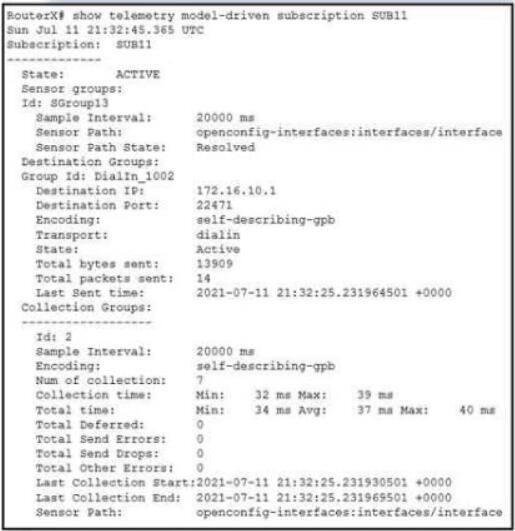
An engineer ran this show telemetry command to view subscription SUB11 on RouterX. The engineer then decided that RouterY should provide the same output for sensor group SGroup13 as RouterX. The engineer cannot access RouterX to copy its configuration No access lists on the router block user access. Which configuration must the engineer apply on RouterY to provide the same output from the show telemetry command?
A. RouterY(config)# telemetry model-driven RouterY(config-model-driven)# subscription SGroup13 RouterY(config-model-driven-subs)# sensor-group-id SGroup13 sample-interval 20000
B. RouterY(config)# telemetry model-driven RouterY(config-model-driven)# sensor-group SGroup13 RouterY(config-model-driven-snsr-grp)# sensor-path openconfig-interfaces:interfaces/interface
C. RouterY(config)# telemetry model-driven RouterY(config-model-driven)# destination-group SUB11 RouterY(config-model-driven-dest)# address family ipv4 172.16.10.1 port 22471 RouterY(config-model-driven-dest-addr)# encoding self-describing-gpb RouterY(config-model-driven-dest-addr)# protocol tcp
D. RouterY(config)# telemetry model-driven RouterY(config-model-driven)# subscription SUB11 RouterY(config-model-driven-subs)# sensor-group-id SGroup13 sample-interval 20000 RouterY(config-model-driven-subs)# destination-id DGroup1
-
Question 23:
What is the primary role of a BR router in a 6rd environment?
A. It provides connectivity between end devices and the IPv4 network
B. It provides IPv4-in-IPv6 encapsulation
C. It connects the CE routers with the IPv6 network
D. It embeds the IPv4 address in the 2002::/16 prefix
-
Question 24:
Refer to the exhibit.
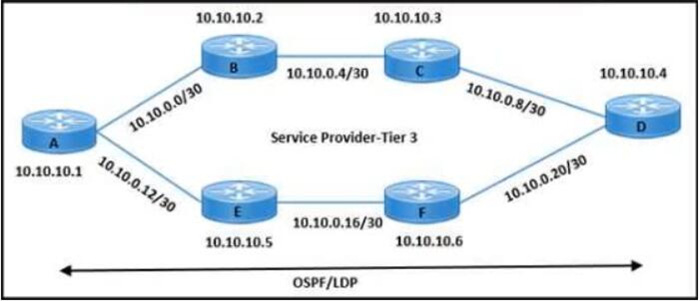
An engineering team must update the network configuration so that data traffic from router A to router D continues in case of a network outage between routers B and C. During a recent outage on the B-C link, the IGP traffic path was switched to the alternate path via routers E and F, but label forwarding did not occur on the new path. Which action ensures that traffic on the end-to-end path continues?
A. Configure the same hello timer values for IGP and LDP
B. Enable LDP Session Protection on routers A and D
C. Bind the BFD protocol with IGP on all routers
D. Enable MPLS LDP IGP Synchronization on all routers
-
Question 25:
Refer to the exhibit.
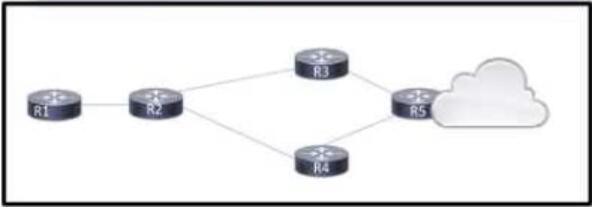
An engineer is scripting ACLs to handle traffic on the given network. The engineer must block users on the network between R1 and R2 from leaving the network through R5, but these users must still be able to access all resources within the administrative domain. How must the engineer implement the ACL configuration?
A. Configure a permit any ACL on the R1 interface to R2 in the egress direction, and a deny any ACL on the interface in the ingress direction
B. Configure an ACL that permits traffic to any internal address, and apply it to the R5 interfaces to R3 and R4 in the egress direction
C. Configure an ACL that denies traffic to any internal address and denies traffic to any external address, and apply it to the R5 interfaces to R3 and R4 in the ingress direction
D. Configure an ACL that permits traffic to all internal networks and denies traffic to any external address, and apply it to the R2 interface to R1 in the ingress direction
-
Question 26:
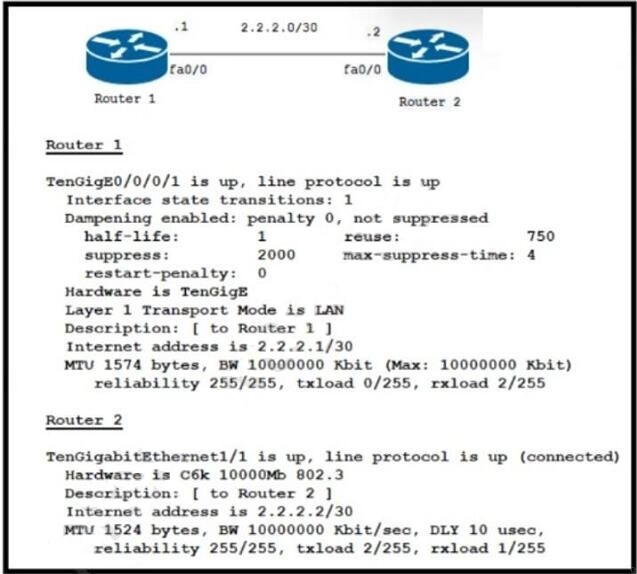
Refer to the exhibit. Router 1 and Router 2 were installed in the data center Router 1 is the core router in the network, but it fails to establish an OSPF peering with Router 2, and customer traffic is unable to pass. Router 1 also reports an increase in CPU and memory usage. However, the CPU for R2 is stable. Which action resolves this issue?
A. Change the MTU to 1524 on Router 1.
B. Disable Cisco Express Forwarding on Router 2.
C. Change the transport mode to WAN on Rooter 1.
D. Enable MPLS on Router 2.
-
Question 27:

Refer to the exhibit. A network engineer received a complaint about these problems in OSPF stub area 100:
The Ethernet link is down between routers RX and RY because the fiber was cut.
CE site A traffic to the hub site is being dropped.
Which action resolves these issues?
A. Change the OSPF area 100 type to stub on RZ.
B. Set the OSPF MTU to 1500 on the link between RX and RZ.
C. Set the OSPF authentication type to MD5 between RX and RY.
D. Change the OSPF priority to 100 on the Interfaces that connect RX and RY.
-
Question 28:
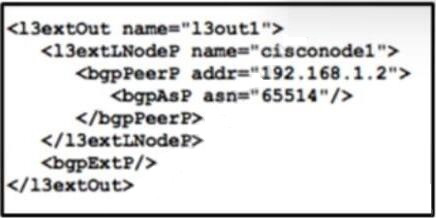
Refer to the exhibit. A global company plans to implement BGP at its newest location to provide connectivity to other offices. The global infrastructure of the company is a multivendor environment. An engineer must review the BGP core configurations at headquarters to determine if they can be repurposed at the new location. The engineer copied this JSON script for review. What is the effect of the script?
A. It configures BGP on the device and inserts 192.168.1.0/24 into the BGP table using the origin AS 65514.
B. It configures a VRF named cisconode1 and a BGP instance using the VPNv4 address family.
C. It configures BGP with neighbor 192.168.1.2 residing in AS 65514.
D. It sets the BGP router-ID to 192.168.1.2 and sets the AS of the router to 65514.
-
Question 29:

Refer to the exhibit. The operations team is implementing an LDP-based configuration in the service-provider core network with these requirements:
RC must establish LDP peering with the loopback IP address as its Router ID.
RA must establish LDP peering with RB, RC, and RY.
How must the team update the network configuration to successfully enable LDP peering between RA and RC?
A. Implement LDP session protection on RA.
B. Enable the mpls ip command on RC interface Gi2/0.
C. Reset the discover hello hold time and interval to their default values.
D. Configure the mpls ldp router-id loopback0 command on RA and RC.
-
Question 30:
What is the purpose of RSVP tear messages?
A. to inform the headend router of LSP issues
B. to confirm successful end-to-end resource allocation
C. to reuse router resources for other reservation requests
D. to notify the tail-end router of resource unavailability on the transit router
Related Exams:
300-510
Implementing Cisco Service Provider Advanced Routing Solutions (SPRI)300-515
Implementing Cisco Service Provider VPN Services (SVPI)300-535
Automating and Programming Cisco Service Provider Solutions (SPAUTO)350-501
Implementing and Operating Cisco Service Provider Network Core Technologies (SPCOR)
Tips on How to Prepare for the Exams
Nowadays, the certification exams become more and more important and required by more and more enterprises when applying for a job. But how to prepare for the exam effectively? How to prepare for the exam in a short time with less efforts? How to get a ideal result and how to find the most reliable resources? Here on Vcedump.com, you will find all the answers. Vcedump.com provide not only Cisco exam questions, answers and explanations but also complete assistance on your exam preparation and certification application. If you are confused on your 350-501 exam preparations and Cisco certification application, do not hesitate to visit our Vcedump.com to find your solutions here.